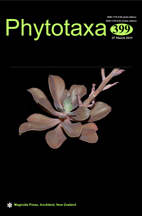Abstract
Calymperes Sw. ex Weber (1813) is the second largest genus in the family Calymperaceae (after Syrrhopodon Schwägrichen (1824: 110)) and comprises approximately 53 accepted species worldwide, mainly distributed in tropical and subtropical regions (Frey & Stech 2009). It is easily separated from other genera of the Calymperaceae by its distinctive sporophytes, which lack peristome teeth, but possess a persistent calyptra. Calymperes palisotii Schwägrichen (1816: 334) is an extremely variable species, occurring from the Neotropics, across Africa, through the islands of the Indian Ocean, to India and Sri Lanka, rarely penetrating eastwards into Indochina and Malesia (Ellis 2018). In their broad concept, Reese & Mohamed (1985) treated many species of Calymperes as synonyms of C. palisotii. These included C. moluccense Schwägrichen (1824: 99) a highly variable species from Malaysia and Oceania. Based on an examination of a wide range of materials of C. palisotii, Ellis (1987) considered that C. moluccense was quite different from C. palisotii, and reinstated C. moluccense as a good species, placing in synonymy with the latter, several taxa also previously regarded as synonyms of C. palisotii (Ellis 1987).

